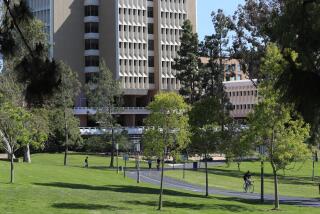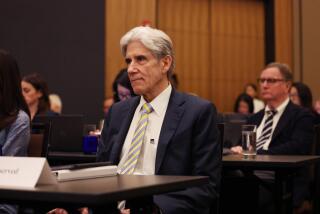Salk Ends Long Search, Names USC Researcher President : Science: Brian E. Henderson will succeed interim president Renato Dulbecco at the La Jolla institute.
- Share via
University of Southern California cancer researcher Brian E. Henderson on Wednesday was named president of the La Jolla-based Salk Institute, ending a search that began in 1988 when longtime Salk President Frederic de Hoffmann unexpectedly resigned.
Henderson, 55, succeeds Renato Dulbecco, a Nobel-laureate scientist who agreed to serve as the institute’s president during the search. Henderson will join researchers at Salk’s scenic bluff-top campus in La Jolla in February.
Salk offered the presidency to Henderson on the strength of his “unique” combination of scientific research and administrative skills, said John Henry Felix, chairman of the Salk’s board of directors.
Henderson “has the qualities needed for leading the Salk Institute into its new phase of development,” Dulbecco said.
Henderson’s acceptance ended a long and frustrating effort by Salk’s board to replace De Hoffmann, who served as president for 18 years. In 1988, Dulbecco was named president, with the anticipation that a successor would soon be named.
But Dulbecco remained at the helm for longer than anticipated because, on at least two occasions, leading candidates unexpectedly backed away at the last minute.
Henderson suggested that De Hoffmann’s unusually long tenure slowed the search for a successor. “It took them a while to decide what kind of a person they were looking for,” Henderson said. “And, to find someone who can mix research with administration is not easy.”
Henderson has been able to juggle that mix of science and administration during 10 years as director of USC’s Kenneth Norris Jr. Comprehensive Cancer Center. “I’ve tried to split my time between administration and my own science on a 50-50 basis,” Henderson said. “And, over time, I think I’ve done that.
Henderson hopes to maintain that split at Salk. “As an epidemiologist, which is very different from laboratory science or a clinician, I work with data,” Henderson said. “And you can work on data (and administrative tasks) at the same desk.”
Henderson described his challenge at Salk as preserving “the atmosphere in which creative discovery can occur. . . . But at the same time, there’s more and more interest . . . in trying to translate good, basic science into things that can be useful to the human population.”
He hopes to make basic science discoveries “relevant” to society without stifling “the opportunities you need for random and free thinking that can and does create discoveries.”
Henderson’s comments echo concerns that Salk founder Jonas Salk voiced during a biotechnology forum at a La Jolla hotel in September.
“We ought to think in terms of what we can do with what we already know, rather than what it is that’s going to (be discovered) in the future,” Salk said. “The capacity we have now for solving problems is considerable.”
Prior to serving as director of USC’s cancer center, Henderson served as professor and chairman of USC’s Department of Preventive Medicine. He joined the university in 1978 as an associate pathology professor. He received his bachelor of arts degree from UC Berkeley in 1958 and a medical degree from the University of Chicago in 1962.
The Salk Institute, which sits atop an ocean-front bluff, was established in 1960 through a grant from the March of Dimes Birth Defects Foundation.
The basic research institute has 530 employees, including 220 who hold medical or advanced scientific degrees. Salk’s 1992 budget will approach $40 million, with two-thirds of its research contracts coming from the federal government.
Salk began its search for a new president in 1988, when De Hoffmann resigned after learning that he had contracted the AIDS virus during a blood transfusion. De Hoffmann died in 1989.
Henderson, who plans to live in La Jolla, has five children. His wife, Judith, is involved in education. “She thinks she will continue to be involved in teaching, but she’s not yet decided where or to what extent,” Henderson said.






